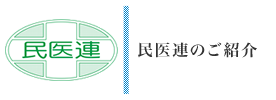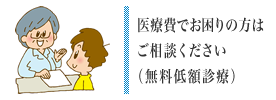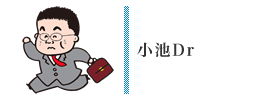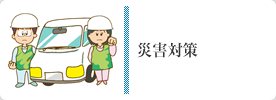english
2011年6月2日
Strong Efforts Made in Communities Where Scars Left by Tsunamis are Still Visible: Marking First Step to Rehabilitation
–Report from Wakabayashi Clinic/ Wakabayashi Friends Association for Health, Miyagi–
By Takeda Tsutomu
“We cannot maintain the sales office for ‘Itsudemo Genki’ magazines due to the earthquake. So please send the future issues to Wakabayashi Clinic.” A telephone call from Wakabayashi Friends Association for Health reached Min-Iren immediately after the March 11 Great East Japan Earthquake. Our reporter visited the clinic in the middle of April.
Looking around for members right after the earthquake
Waiting for the reporter was Mr. Otomo Mutsuo, the Association’s Vice President, and Ms. Sato Machiko, Secretary.
Mr. Otomo was at home when the quake hit. When the shake subsided, the first thing that came to his mind was about his fellow members in the Association. “So I came near the clinic, in order to visit solitary old people and some members of concern.”
Just then, he witnessed tsunami, looking like a black wall, rushing toward him from the seaside. His house, which stood near the sea, was engulfed in the tsunami. His wife, who was at home then, fortunately survived. “She stayed upstairs of the house overnight, and was rescued by a helicopter next day,” he said.
As one of the pine trees uprooted by the tsunami from the tide-water control forest has been stuck in their house, they are still forced to live in the evacuation center.
“Warmth of the people touched the core of my heart”
Ms. Sato, living in the neighborhood of Mr. Otomo, was away from home when the earthquake hit. She came back home and was cleaning up the mess, when she heard someone say, “Tsunami is coming!” She drove away again, while urging neighbors to evacuate, too.
Ms. Sato has seven members in her family. Fortunately all of them survived, and were able to meet at the evacuation center. She has a grandchild, who was born only in January this year. For the first few days they stayed at their friend’s house, and a week later, they moved to a rental house.
“While we lived in our friend’s house, one of our members delivered food and baby’s diapers to our place for 4 days consecutively since the evening of the earthquake, saying, ‘It must be difficult living like this with a baby.” She joined our association some time ago at my invitation, though she lived outside this area.”
“Also some others invited us to their house, saying, ‘Feel free to give a bath to your baby at my house.’ When we moved, many people donated a washing machine, refrigerator and tableware. People’s warmth touched the core of my heart as never before,” Ms. Sato said.
Long queue in front of the clinic
“In the midst of strong shocks of the earthquake, the faces of patients of concern passed through my mind,” said Mr. Kato Takao, the director of Wakabayashi Clinic. After the initial shocks subsided, he discussed with the clinic staff how they would visit patients they regularly make house calls at, including a man in his 90s with a level 5 nursing care need, attended by his daughter.
But just when they were about to leave the clinic by car, a neighbor stopped them, saying, “Tsunami is coming!” So they were led by others and evacuated to a nearby primary school.
Fortunately the tsunami came only as far as the parking lot of the clinic. Although the building escaped from inundation with water, patients’ medical records were scattered everywhere and computers were not usable because of power outage. “The clinic was far from operable for seeing patients,” Mr. Kato said.
However, at the beginning of the next week, patients were already queuing before the clinic in the morning, waiting for medical care. With no choice but to open the clinic, the staff resumed the operation, based on the prescription cards they had managed to dig out among the piles of documents scattered around by the earthquake.
Patients not only claimed, “I cannot sleep,” or “My blood pressure is rising,” but also showed the spurt of their horror of the earthquake and tsunami and the sorrow and pain for losing their families and friends. The clinic saw a total of 163 patients during the period from March 14 to 19. Doctors took time and carefully examined each patient with great care, in support of the victims’ physical and mental health.
Hope for rehabilitation of the community
About 500 members of the Wakabayashi Friends Association for Health used to live in the vicinity of the clinic. Though the staff of the clinic make rounds at different evacuation centers, the details of their whereabouts and the situation of damage has not been made clear. In order to grasp the overall picture of the damage on them, the clinic is preparing a questionnaire to collect information on the damage incurred and the difficulties each member face at present.
Mr. Otomo said firmly, “In utilizing the route for delivering our newsletter, we want to find out the current situation of each member. It would help our association start joining the movement for the rehabilitation of the community.”
Mr. Otomo also has requests toward the national/local governments. “They should show a vision for rehabilitation, even in broad terms. Without it, people cannot know if they can rebuild their homes at the same place or not. There should be an examination on housing of people, including the possibility of their mass migration to a safer place. Also, people’s life and living, as well as employment, should be secured by the effort of the government.” Ms. Sato, whose husband was dismissed as of the end of March due to the earthquake, nodded earnestly.
Grasping the situation of damage by a door-to-door visit
On April 14, with the support of Min-Iren’s affiliates from other parts of the country, mass visits to all houses in the surrounding area of the clinic were carried out. Ms. Kyo Reiko, the head nurse of the clinic, also took part.
Most of the houses in the area Ms. Kyo visited were flooded above floor level. At one house, all 4 cars in possession became inoperable, and at another, large amount of sludge filled the underfloor space of the house. At the house of a craftsman, machineries and tools incurred rusting due to flooding in seawater.
Many farmers in the area also suffered inundation of their farm machinery and implement in seawater. But what mattered most were their farmlands. After they were damaged by seawater, “I cannot know whether I can harvest the crops or not until I actually cultivate,” a man said.
The clinic staff saw a woman who was “on Shinkansen superexpress train coming back from Tokyo when the earthquake hit.” She said, “As March 10 was the anniversary of the Great Tokyo Air Raid, I took my 85-year-old mother in wheelchairs to visit her family grave.”
When she reached home several days later, she found the sludge in the house after flooding above the floor, and all the electronic appliances were broken. But she was concerned about other victims, saying, “I may be more fortunate than others, as I can still live in my own house.”
She is a member of the Friends Association of Nagamachi Hospital, which also belongs to Miyagi Health Society as Wakabayashi Clinic does. She is also a member of the “Singing Voice” movement, just as Ms. Sato. She said, “Please tell Ms. Sato, ‘Let’s sing again together.’ Now is the time we need to hold some events and have fun.”
Now that a month has passed since the great earthquake, “The absence of some patients has come to our notice. We need to confirm the safety of these patients as soon as possible,” said Mr. Kato.
When can the people congratulate for a full rehabilitation of the community? Until the day when they can truly share the joy with each other, hard work and efforts by the Friends Association members and Min-Iren workers will continue.
 この記事を見た人はこんな記事も見ています。
この記事を見た人はこんな記事も見ています。










